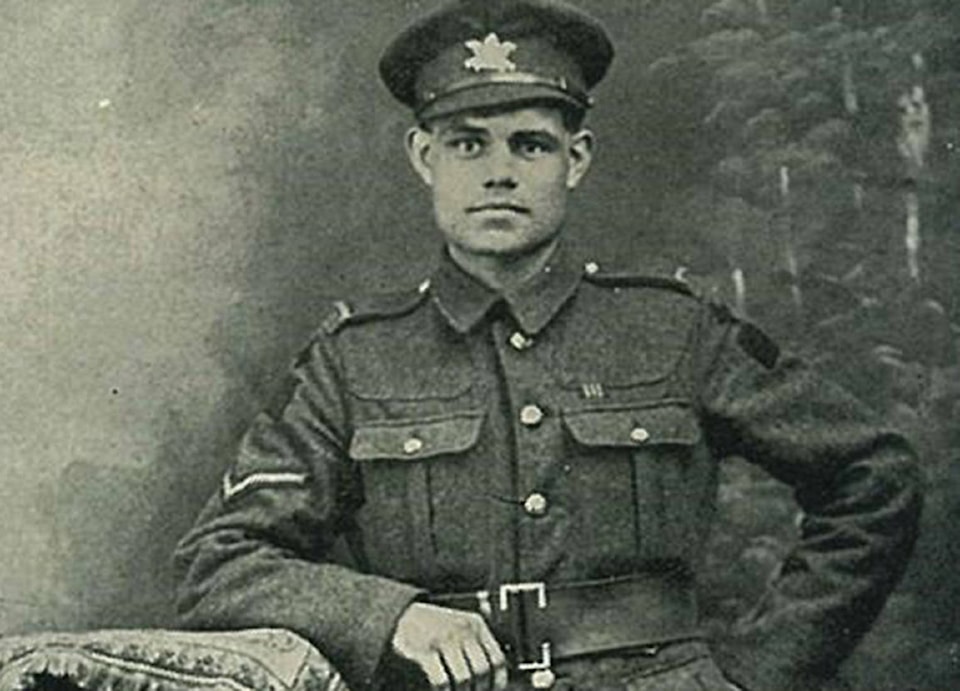Jacqueline Carmichael pored over her grandfathers���߲��о���� letters for several weeks. She read the long, handwritten notes, and the short ones scribbled perhaps in a hurry as the men hunkered down in trenches while dirt and bullets from the First World War showered over their heads.
Through those disjointed accounts, Carmichael says she has opened a window to her past that helps her understand the person she is today.
The First World War saw about 75 million letters exchanged between the front lines and the 650,000 men serving in battle.
A hundred years later, most notes have vanished or are a distant, yellowed memory. The words are only just visible, and the photos are cloudy.
Carmichael, a resident of Port Alberni, B.C., and the author of ���߲��о����Tweets from the Trenches: Little True Stories of Life and Death on the Western Front,���߲��о���� says she wanted to find a way to link the past to the present because both her grandfathers served in the war.
George ���߲��о����Black Jack���߲��о���� Vowel and Charles W.C. Chapman enlisted when they were in their early 20s, just as the war began in 1914, and served till the end of the war in 1919.
���߲��о����I found in my grandfathers���߲��о���� letters and journals a way to understand them.���߲��о����
The war shaped her family and ultimately helped her become the person she is, Carmichael says.
���߲��о����It was 100 years ago and we see it as this black-and-white war in these black-and-white pictures and it seems very distant and historic but it���߲��о����s with us in our DNA.���߲��о����
Tim Cook, a historian at the Canadian War Museum, says the First World War was one of those key events in the nation���߲��о����s history that shaped the country.
���߲��о����We were forever changed by the war.���߲��о����
While events such as women receiving the right to vote, the imposition of income tax, the Treaty of Versailles and the conscription crisis emerged during the war, he says the most powerful legacy was the more than 66,000 Canadians killed.
Cook says he���߲��о����s always been interested in how these men coped and endured the trenches and struggled to hold onto their humanity despite what they saw. Some broke down, some were killed but others kept going forward, fighting and serving.
WATCH: Veterans appreciation day in Chilliwack, B.C.
���߲��о����I���߲��о����ve turned to those letters and diaries as a powerful way to understand the motivation and inner lives of soldiers in the First World War.���߲��о����
Carmichael was given the letters and a few of Vowel���߲��о����s pocket journals by her aunt in 2007.
Some of the notes were on postcards and were short enough that they could have been tweets, she says.
A century later with email, Twitter, Facebook, Instagram and instant messages, such postcards seem quaint but they were the only link between soldiers and home.
Vowel returned damaged from the war, she says, adding his letters hint at some of the horrors of his experience: ���߲��о����Delivering rations to the front, dodging bullets and mortar fire both. Bullets ripped the dirt up all around me but none of them were marked Black Jack.���߲��о����
���߲��о����The front is just the place for a person that likes thrills,���߲��о���� Vowel writes in another letter. ���߲��о����The noise made by high explosive makes your hair stand on end.���߲��о����
He died in a tractor accident before Carmichael was born.
���߲��о����I tried to make some sense of what kind of men they became and in turn what kind of fathers they became,���߲��о���� she says of reading the letters.
Chapman came out of the war as a loving father and husband, she says.
Grandpa Charlie had a laugh that rumbled in his chest because mustard gas had damaged his lungs, she recalls.
���߲��о����He was a very kind person, and he had a great sense of humour. I have vivid memories of him whenever I smell pipe tobacco.���߲��о����
When his children asked him about the war, she says he would chuckle and simply say he never killed anyone, just practiced shooting on bully-beef cans, referring to the rations distributed to soldiers.
���߲��о����The way that families are shaped, the way that families relate to each other, I think we are affected by better or for worse by that war,���߲��о���� Carmichael says.
Stephen Davies, a Vancouver Island University history professor and director of the Canadian Letters and Images Project, an online archive of the Canadian war experience, says the letters put a human face to the war.
���߲��о����These are young men, they had loves and lives and ambitions and they liked chocolates and their dogs and had a girlfriend. They are very real accounts of real people.���߲��о����
Davies���߲��о���� grandfather, Harry Davies, enlisted in 1916 when he was 18. He served until he was wounded in August 1918.
There are no letters from his grandfather but he has his daily diary and a few photographs, all of which are in the online collection.
His grandfather died in 1935 and they never had met, but Davies says the diary has given the man a voice.
When people go to a cenotaph and look at the names, they tend to think of the soldiers as old men. But when people look at their letters, they realize that they were young, Davies says.
���߲��о����Through those letters we know what rich lives they had and by their loss, you know what a richness that was lost through the war.���߲��о����
War letters aren���߲��о����t necessarily about war, Davies adds.
Soldiers didn���߲��о����t write about the horrors they faced, instead their letters are tinged with a longing for home, he says.
Hina Alam, The Canadian Press
Like us on and follow us on .



